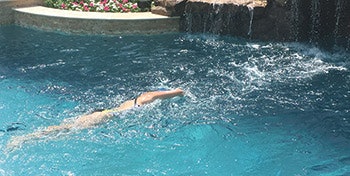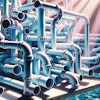Modern, high-end backyard pools have great aspirations — they want to be more than just a bowl of water. Some want features akin to a waterpark. They all want to look like a painting.
The palette may include dozens of items — natural stone, decking, landscaping, coping, tile, firebowls, lighting, etc. — but rarely does the designer consider the look of the pool water itself. While the tile gleams and the water features trickle, the water in the pool remains as static as glass. Adding current changes the look of the pool to the delight of some clients, who simply enjoy the sense of motion and energy in the water.
To their own surprise, however, these same pool owners often find their kids are the biggest proponents of current systems, as they find creative ways to use water currents for hot afternoon fun. Leo Kleiweg, president of Paragon Pools in Houston, has seen this dynamic play out among his clients. He says that adults often think of current systems as an exercise product, and they're sort of right — but it's their kids who get the most exercise.
{bglink 4425}
"I always use the personal example of how the wife and I wanted to exercise more, so we went to Costco and bought a nice treadmill," he says. "We had every intention of using it, but in the end, we really never got around to it. So when customers start talking to me about swim systems, I like to ask them about the fun part. I encourage them to think about the entertainment aspect of the swim system — the kids getting out their tubes and shooting across the pool — instead of the exercise part.
"Because what I've learned and seen firsthand is that more often than not, it's the kids that use the current system most, and just for fun. The parents may use it for exercise, but the kids will use it more."
Kleiweg recalls a female client who was a triathlete. Her pool was relatively large — 60 feet long, plenty of room for swimming — but she wanted to train without turns using the swim in place concept.
"So I came up with the idea of current coming out of a grotto cave, with a waterfall splashing into it, so the kids can jump through the waterfall and shoot along in the current. I told her, 'You can use it for swimming and the kids can use it, too.'
"Well, she uses it very little and the kids use it all day every day when they swim. They grab floats, jump into the current and shoot across the pool. And that situation seems to be the standard in my experience; I think it's more of an entertainment item."
Unintended Fun
You never know what people will do with current in water, says Peter Davidson, president of Current Systems. "What was designed as a swimming application for parents — well, the kids got creative. They got in there and found their own uses for it. Just as you see by a river or ocean, where there's moving water and people playing in it, there's a fascination with water moving fast through a swimming pool."
Another current-in-water application that has found wide appeal is the lazy river. In the last five years or so, Current Systems has seen an increase in demand for this type of laid back aquatic experience. Davidson says, "People have been enjoying these in waterparks and coming home, calling their builder and telling him, 'We want you to shrink down the lazy river at Magic Mountain Resort.'"
These residential systems can take any shape, but a common one is to simply loop the river away from the pool and back, leaving the client with not just a lazy river, but a charming bridge and an island in the middle for relaxing.
High Volume
Moving water for any application requires a pump, but the pumps in high-end current systems differ from standard pool pumps. Ordinary circulation pumps create significant pressure and relatively low flow volume in order to crank water through plumbing and back into a pool.
A current system on a high-end project is looking to move volumes that are ten to twenty times greater — perhaps something in the range of 2000 to 2400 gpm. Trying to move that much water with a standard pool pump would use a tremendous amount of energy.
"In contrast with typical filtration pumps, we create low pressure and high volume," Davidson says. "One of our 7.5-hp pumps is capable of producing the same flow rate in gpm as, say, ten 3-hp swimming pool pumps. So for a fraction of the horsepower that would be needed using typical swimming pool pumps, we can create tremendous flow. It's not a violent kind of energy, it's a low-pressure, manageable, adjustable current you match up to the resistance you like against your body.
"It should not be confused with a swim-jet, which is more like a Jacuzzi jet which is pumping aerated, turbulent water through a nozzle. That does what it's supposed to do, but it's a different experience," adds Phil de Tournillon, Vice President of Current Systems.
Builder Payoff
 Click to enlarge
Click to enlarge
Davidson and his peers hope to see Current Systems grow in popularity to the point where they are considered an ordinary option when assembling a package for a high-end pool project.
"The advantage for the contractor is profit," Davidson says. "Going this route, they'll probably profit by another $5,000 or so by adding this type of system to a package. And it offers them something that makes their pool unique, and excites the customers."
Pool builders and backyard designers tend to focus on the areas around the pool, he adds, but current systems give the builder the opportunity to show off the water.
"There's been a lot of education in things like fire and glass tile applications, and the infinity edges, and they're truly works of art, these pools. But relatively few people are aware of what they can do with the water itself, and the benefits that come from that."
Comments or thoughts on this article? Please e-mail [email protected].








































